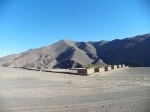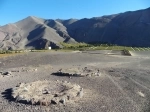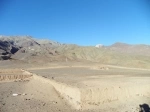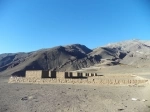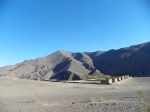Viña del Cerro in Copiapo. Copiapo - CHILE
Viña del Cerro is a setting for the smelting of copper, despite the continued looting that has been subjected, is one of the sites of the best preserved Incan era Chilean Norte Chico. It is situated atop a rocky spur progress toward the Copiapo valley from the Sierra del Puppeteer, 80 km upstream from the present city of Copiapo and 1,100 meters above sea level.
The cast is composed of a large rectangular courtyard or kancha in the flat and broad sector of the top, bordered by a low perimeter wall, built of stone and adobe, with its crown probably staged to suit the terrain. In southern and eastern walls has large openings or entrances. This unit includes a group considered the camp to the workforce and a platform or ushnu.
The camp backs onto the western end of the Kancha, within a rectangular space with a perimeter wall delimiting. Two intersecting walls identifies three roughly equal-sized rectangles, which are separate, but connected by their respective openings into the yard more. At the western end of each of these areas stand side two sites symmetrically rectangular, completing about six rooms. The enclosures have semicanteadas angled stones from the hill and adobe clay, all together with mortar made from the same material and are isolated by aisles on all four sides. The walls were plastered with mud plaster beaten.
For its part, the platform or ushnu is located in the northeastern corner of the courtyard. It has a slightly trapezoidal shape and had an access staircase with seven steps. Constructively neatly filling was achieved with a perimeter wall adobe stones closed parallelepipeds. According to colonial documents, the structure symbolized the authority of the Inka and since he probably exercised the administration of the establishment, and religious ceremonies.
Situated at an elevation lower than the previous one, there is another kancha rectangular, nearly square, bounded by a perimeter wall with access. In its northeast corner is a compound similar to the camp, but with the difference that in its inner third has a small platform attached to the wall. Was supposed to be the room of the authorities. A little further up is a set of 26 foundations of ovens or huaira organized in three parallel rows on a hill very airy. The foundations are circular or elliptical, 2 to 3 m in diameter, composed of stone or adobe emplantillados protruding from the surface. Finally, are the foundations of a rectangular house, built on a small plain in the middle of the hillside, near a slope. It is thought that from here the water was channeled through metal reeds to installation.
However, excavations of the site confirms that most material remains concentrated around the camp was, as even stones were found mills, refractory crucibles and molds used in casting, copper and ceramic. No doubt Viña del Cerro metallurgical center represents most complete and best organized of the Inca expansion era in Chile. The ore probably came in convoys of flame and crushing after a selection on hand. The workforce employed in the establishment would come from a village in Indian-diaguitas, near the mine where the ore was obtained, and other inhabitants of the highlands of Copiapo.
